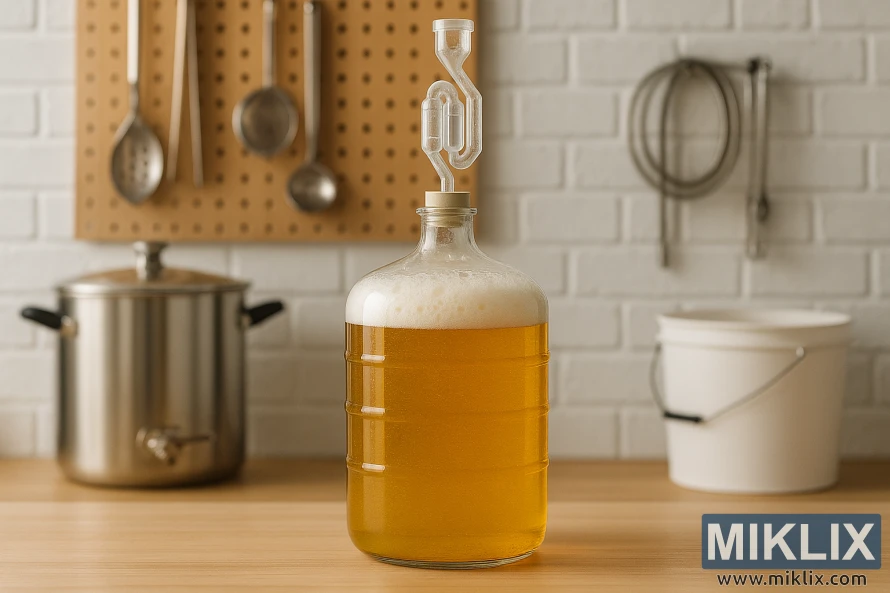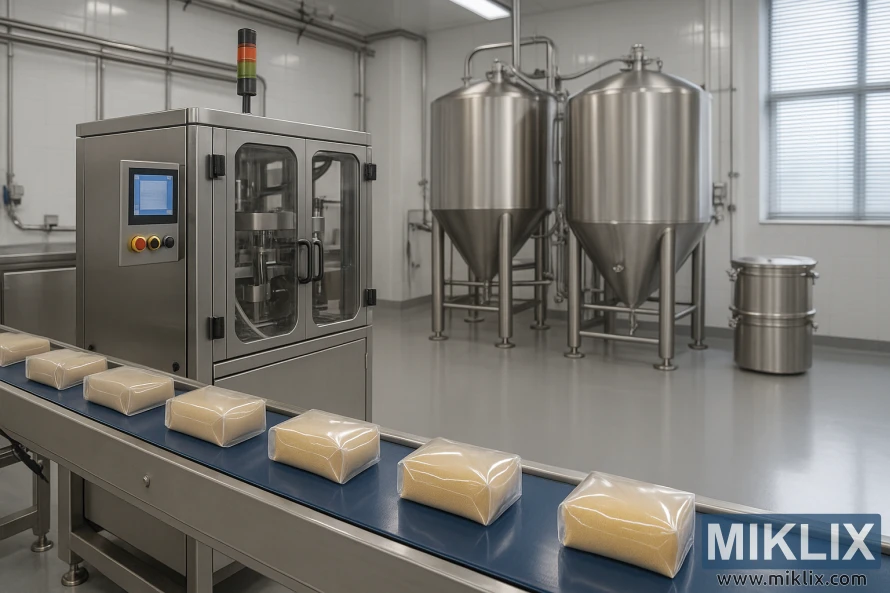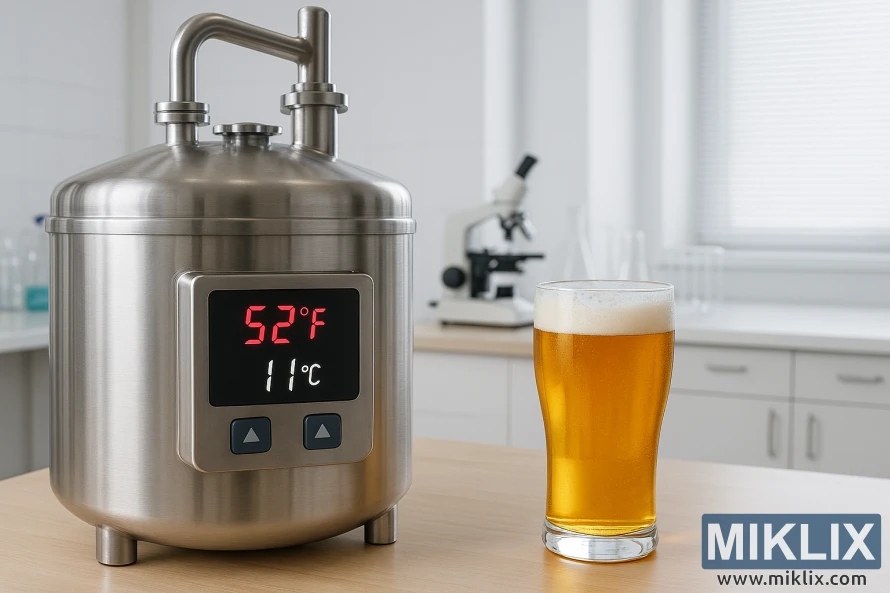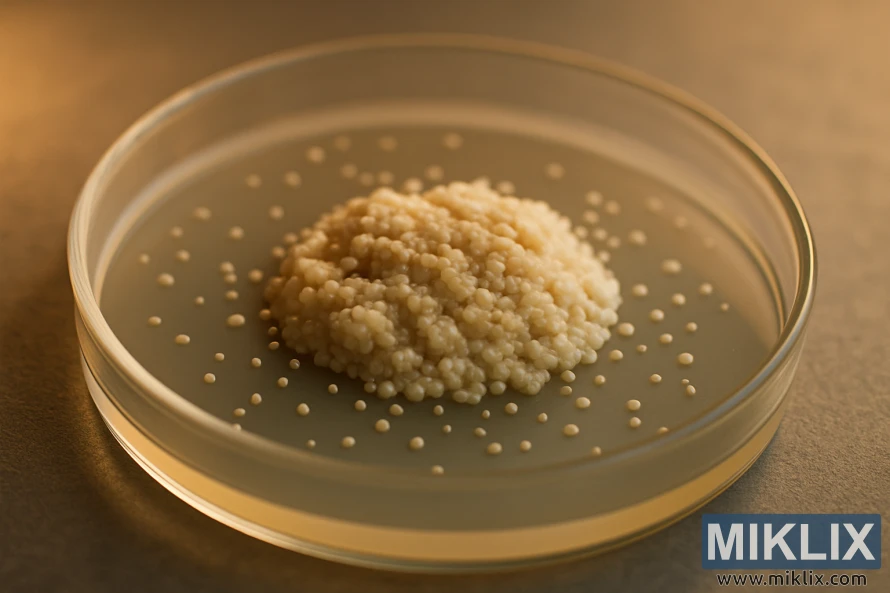Fermenting Beer with Lallemand LalBrew Diamond Lager Yeast
Published: September 19, 2025 at 6:49:52 PM UTC
This article delves into the specifics of Lallemand LalBrew Diamond Lager Yeast for homebrewers. It aims to assess its ability to produce crisp, clean lagers and its reliability in fermentation. The focus is on how well Diamond meets these expectations in typical homebrew setups.

Feedback from brewers indicates that Diamond excels in temperatures around 50s °F. It may take 24–48 hours for the first signs of fermentation to appear. Once active, it brings out the classic lager aromas, including a mild sulphury note that diminishes with time. These observations are echoed in numerous Diamond lager reviews and online forums.
Practical considerations include the pitching temperature and the number of packets needed for a 5+ gallon batch. Many brewers opt for two packets. Temperature control is also key, with common methods including fermentation in a basement at 55°F or using a chest freezer with a controller for more precise control.
This introduction outlines the focus of the article, including detailed advice on pitching, starter cultures, and fermentation temperatures. Troubleshooting tips will also be provided to help you achieve the best results with Lallemand LalBrew Diamond Lager Yeast.
Key Takeaways
- Lallemand LalBrew Diamond Lager Yeast is designed for clean, crisp lagers.
- Works well in the 50s °F; initial activity may be slow for 24–48 hours.
- Common practice is two packets for 5+ gallon batches with careful pitching temperature.
- Expect mild sulphury aromas during active fermentation that subside during conditioning.
- Basement fermentation or a chest freezer with a controller are common setup choices.
Why Choose Diamond Lager Yeast for Crisp, Clean Lagers
LalBrew Diamond is the go-to for brewers seeking a clean lager yeast. It excels in producing crisp, neutral beers. Its characteristics are ideal for pale lagers and continental styles, resulting in a clear, golden hue and a subtle aroma.
Users find Diamond's fermentation consistent, with minimal ester production when fermentation and conditioning are done right. This neutrality allows the flavors of hops and malt to stand out, without the yeast overpowering them with fruity notes or harsh phenolics.
Diamond is reliable across typical lager temperatures, making it a dependable choice for homebrewers. It's also a great substitute for contaminated liquid cultures, ensuring good attenuation and clarity.
- Clean fermentation behavior that produces a stable, neutral canvas.
- Diamond lager characteristics that suit light to medium-bodied lagers.
- Predictable lager flavor profile prized in classic continental beers.
- Reliable fermentation for brewers seeking consistent results.
For those aiming for authentic lagers, LalBrew Diamond makes the journey simpler. It minimizes the uncertainty of fermentation, allowing brewers to confidently bottle or keg their clean, bright creations.
Packaging, Availability, and Product Details
Lallemand markets LalBrew Diamond as a commercial dry lager yeast for homebrewers and small breweries. It comes in sealed packets, ensuring viability and simplifying storage for those planning multiple batches.
Retailers' websites provide detailed information on LalBrew Diamond's packaging, cell counts, and customer feedback. They help brewers compare options and decide on the right quantity for a five-gallon lager. Many opt for two packets for their first lager to guarantee robust fermentation.
Yeast availability can change with the season and retailer. Local shops and online stores frequently carry Diamond lager yeast. Listings indicate current stock levels. Retailers may offer shipping deals and satisfaction guarantees, impacting the decision on where to purchase.
Before brewing, check the product details for storage and batch guidelines. The packaging clearly states it's for dry yeast packets, includes rehydration instructions, and provides Lallemand's contact information. This ensures the purchase is authentic.
In the United States, searching for reputable suppliers and specialty brew shops is key. They offer price comparisons, shipping details, and stock updates. Clear product pages facilitate easy comparison, helping to choose the best place to buy Diamond lager yeast and confirming availability.

Understanding Recommended Fermentation Temperatures
Lallemand LalBrew Diamond thrives under consistent conditions. Most brewers aim for a Diamond fermentation temperature in the low-to-mid 50s F. The consensus is that lager fermentation should occur between 50–58°F for a clean, crisp taste.
Many homebrewers achieve success by fermenting between 48°F and 55°F. They often use a cool basement or a chest freezer with a controller to maintain this temperature. This approach helps preserve the delicate flavors of malt and hops, while minimizing fruity esters.
During the first 24 hours, expect slow activity at around 50°F. By 48 hours, bubbles and krausen become more visible. Diamond fermentation is known to start slowly but then gain momentum steadily, without violent foaming.
Consistent temperature control is key to avoiding unwanted esters or sulfuric tones. It's important to maintain a steady lager fermentation temperature of 50–58°F. This helps keep diacetyl production low and supports clean attenuation.
Experienced brewers recommend setting the chest freezer controller a degree or two lower than the target temperature. This compensates for the heat generated by active fermentation. Monitoring temperatures with a probe is essential. Small, steady adjustments are better than wide fluctuations for achieving the classic lager character.
Pitching Temperature and Best Practices
Pitching dry lager yeast into wort requires careful attention. Most brewers recommend pitching at fermentation temperature or slightly below. For LalBrew Diamond, aiming for 50–54°F is ideal when fermenting between 51–58°F.
Many brewers prefer pitching around 50–53°F, avoiding the start at warmer ale temperatures. Starting warm and then cooling can stress the yeast. This stress increases the risk of off-flavors and longer lag times.
Adhering to yeast pitching best practices is essential. This includes gentle aeration, clean equipment, and precise pitching rates. Dry strains can be pitched directly without rehydration, but follow Lallemand's advice on this.
Some brewers warm the fermenter after pitching to speed up fermentation. This method should be used sparingly. Many prioritize beer quality over rapid fermentation onset.
- Target pitching temperature for Diamond: 50–54°F when fermenting at roughly 51–58°F.
- Pitch at fermentation temp or slightly cooler; avoid pitching very warm and cooling later.
- Expect minimal early airlock activity; don’t judge fermentation solely by bubbling.
Adopting yeast pitching best practices minimizes stress and enhances attenuation. Proper temperature control at the beginning is key to achieving a clean, balanced lager.

Starter and Pitch Rate Guidance for LalBrew Diamond
For a first lager in a 5+ gallon batch, many homebrewers follow a two-packet recommendation. This ensures vigorous fermentation. LalBrew Diamond suggests modest overpitching to avoid underpitching, which is critical for stronger original gravities.
Dry yeasts are robust, yet a yeast starter for dry yeast can be beneficial. It's useful when gravity is high or when you plan to repitch. Creating a starter from a rehydrated dry yeast slurry increases cell count and shortens lag phase. This lowers the chance of off-flavors.
- Use two packets for standard 5–6 gallon lagers as a baseline.
- Increase pitch rate for higher gravity worts or larger volumes.
- If you choose one packet, plan a yeast starter for dry yeast to boost viability.
Shorter lag phase improves fermentation health and flavor. A correct LalBrew Diamond pitch rate reduces diacetyl and esters by getting yeast active sooner. Brewers aiming to avoid underpitching often find the two-packet approach simple and reliable.
When in doubt, measure gravity and calculate cells or opt for the two-packet recommendation. This small step keeps fermentations clean and predictable. It protects your beer from common fermentation faults.
Fermentation Management: From Lag Phase to Diacetyl Rest
LalBrew Diamond yeast typically experiences a brief lag phase at standard lager temperatures. The initial 24 hours often see a slow start, more pronounced at the lower end of the recommended range. Around 48 hours, active fermentation usually begins when conditions are optimal.
Reliance on a hydrometer for fermentation monitoring is advisable over airlock activity. Regular gravity readings confirm sugar consumption, eliminating the need for speculation. This approach minimizes stress related to the early quiet phase.
Implementing a diacetyl rest lager yeast step near the end of primary fermentation is essential. A slight temperature increase encourages yeast to reabsorb diacetyl. Homebrewers often elevate temperatures to 56–58°F when fermentation nears completion, as indicated by gravity readings.
Timing the temperature increase is critical, based on gravity changes and yeast activity. A modest rise can expedite cleanup and enhance attenuation if gravity has slowed but not finished. Gradual changes are necessary to avoid shocking the yeast.
Documenting temperatures, gravity, and timing is vital. Clear records facilitate the replication of successful brews with Diamond yeast. Patience and meticulous control over temperature and sanitation are key to achieving cleaner lagers.
- Check gravity, not bubbles, for progress.
- Expect 24–48 hours before visible activity increases.
- Raise temperature a few degrees for a diacetyl rest lager yeast cleanup.
- Avoid rushing primary fermentation; let the yeast finish its work.

Temperature Control Options for Homebrewers
Effective temperature control is key to brewing a clean lager. For many, fermenting in a cool basement near 50–55°F is the simplest method. This approach eliminates the need for electronics and ensures yeast behaves predictably.
Without access to a basement, using a chest freezer with a dedicated temperature controller is a viable alternative. Controllers like Inkbird or Johnson Controls offer precise temperature control. This setup allows for programming a diacetyl rest, providing accurate results without a high initial investment.
For those on a budget, options include using a small fridge with an external controller or placing the fermenter in a tub of cool water. Ice packs can be swapped out for quick temperature adjustments. Some brewers employ a glycol chiller for rapid temperature drops, then let the controller adjust to the target temperature.
- Basement lagering: minimal cost, best for naturally cool homes.
- Chest freezer fermentation: precise control, common choice for hobbyists.
- Water baths and ice packs: quick, temporary adjustments that work in a pinch.
Consistency is more important than achieving perfect temperatures. Small temperature spikes, like opening a freezer door, can increase airlock activity. These minor fluctuations rarely harm a batch, as long as the overall temperature range remains within acceptable limits.
Monitoring and setting alarms are essential. Keeping detailed logs helps identify trends and refine your temperature control techniques. Even small investments can lead to cleaner, more consistent lagers over time.
Attenuation, Flavor Outcomes, and Troubleshooting
LalBrew Diamond is known for its clean attenuation, perfect for pale lagers. It offers a firm finish, even with simple malt bills. For a crisp lager, expect good clarity after proper conditioning and cold lagering.
Common lager flavors include a neutral, rounded malt backbone with low ester presence. Proper fermentation and conditioning result in bright malt notes and minimal off-flavors. A light tan yeast layer on the wort before active bubbling is usually settling yeast, not a defect.
If fermentation is slow after 48 hours, start troubleshooting Diamond yeast. Check the pitch rate, temperature, and sanitation. Slow starts are normal at lower lager temperatures. Confirm gravity readings before making significant changes. Raising the temperature a few degrees can stimulate yeast without harming the final profile.
Consider slow fermentation fixes such as making a starter or using two packets on early batches if underpitching is suspected. Measure specific gravity over time to confirm progress. If gravity stalls, evaluate oxygenation and nutrient levels before repitching or warming the fermenter.
- Watch for steady gravity drops, not just surface activity.
- Adjust pitch rate or add a starter for high-gravity or underpitched beers.
- Use controlled temperature increases to revive sluggish fermentations.
Keeping good records of original and current gravity readings helps diagnose issues and verify Diamond attenuation for future brews. Proper pitching, temperature control, and patience are key when troubleshooting Diamond yeast and achieving desired lager flavor outcomes.
Clarification, Finings, and Lagering Practices
After primary fermentation, allow the beer to rest for a brief conditioning period. Perform a diacetyl rest near 60–65°F for 24–48 hours to help LalBrew Diamond finish buttery precursors. Then begin the drop to cold conditioning Diamond yeast by lowering temperature gradually to lager temps.
Most homebrewers keg after a couple weeks, but many report that extended lagering practices yield better results. Aim for 3–4 weeks near 34–38°F to let flavors mature and harsh esters mellow. Patience here improves mouthfeel and long-term stability.
Use cold-crash techniques to speed sedimentation before transfer. Chill the fermenter to just above freezing for 24–72 hours to promote lager clarification. This step reduces yeast and protein haze, making downstream fining lagers more effective.
Common fining agents include gelatin and Irish moss. Add gelatin after cold-crash for rapid clearing. Be mindful of dosing and timing to avoid stripping delicate hop character in lighter lagers.
For natural clarity, allow gravity and time to do the work. Gentle racking from the trub minimizes redepositing solids. If serving too early, tasters often call the beer "a bit green." Extended cold conditioning Diamond yeast corrects that by rounding flavors and improving clarity.
Consider secondary conditioning in a keg or bright tank for final polishing. Keep storage temperatures steady and avoid agitation to let suspended particles settle. These combined lagering practices and proper fining lagers steps produce the clean, crisp profile expected from classic lagers.

Repitching and Harvesting LalBrew Diamond Yeast
Homebrewers often debate whether to repitch LalBrew Diamond yeast or harvest dry yeast for future brews. LalBrew Diamond is marketed as a dry yeast for single use. This approach ensures consistent attenuation and clean lager character.
Some brewers prefer to harvest slurry from fermenters for reuse, a common practice with liquid cultures. This method can save money and expedite brewing schedules. Yet, it carries risks. Harvested yeast must be visibly healthy, handled with strict sanitation, and stored cold to maintain vitality.
Community reports reveal mixed outcomes from LalBrew repitching attempts. A few brewers have successfully carried cultures for generations with meticulous care. Performance generally declines after multiple generations, leading to slower starts or off-flavors.
- Check viability: use a microscope or a simple viability test before reuse.
- Limit generations: avoid more than two to three repitches to reduce drift.
- Sanitize thoroughly: contamination is the main hazard when you harvest dry yeast.
Many homebrewers opt for fresh packets for each batch to ensure dependable results. This method eliminates uncertainty and supports consistent fermentation timelines for lagers.
If you decide to harvest, develop a yeast management plan. Consider batch gravity, fermentation temperature, and brewing frequency. Keep track of repitching history and watch for signs of stress. This will help you know when to switch back to fresh LalBrew Diamond packets.
Real-World Homebrew Experiences and Tips
Homebrewers share practical tips on using Diamond yeast. First-timers often ferment at 55°F in basements or cool rooms. Some use two packets to avoid underpitching, as starters can be impractical.
Experienced brewers note modest airlock activity in the first days. They describe a classic lager scent with light sulphury notes as fermentation intensifies. This smell typically fades as activity peaks and the yeast settles.
Practical tips for lager brewing include mash temps of 150–154°F for balanced bodies and clean finishes. Brewers stress patience and using a hydrometer for gravity checks, avoiding airlock reliance.
Practical troubleshooting tips emphasize pitching at or near the target fermentation temperature. If fermentation seems slow, raise the temperature toward the upper end of the recommended range. Avoid repitching immediately.
- Expect modest krausen and a steady, not violent, ferment.
- Prioritize a proper pitch rate; two packets can reduce risk for larger batches.
- Use hydrometer readings to confirm progress before taking corrective action.
Other troubleshooting anecdotes caution against shortcuts that compromise flavor. Brewers achieve better clarity and fewer off-flavors by closely matching pitch and fermentation temps.
Collective experiences show that small adjustments—like timing diacetyl rests and slow cooling during lagering—yield cleaner lagers. These tips reflect hands-on trials from hobbyists and small-scale breweries.
Lallemand LalBrew Diamond Lager Yeast
LalBrew Diamond is a dry lager yeast from Lallemand, perfect for homebrewers aiming for clean, reliable fermentations. This concise review highlights its steady attenuation, low ester production, and strong flocculation. These traits help beers clear after lagering.
The packaging of LalBrew Diamond is widely available in the U.S. through homebrew shops and online retailers. It's commonly purchased in single packets or multi-packs. Many American homebrewers start with two packets for five-gallon batches to ensure a healthy pitch.
Its performance at low temperatures is a key strength. LalBrew Diamond handles basement fermenting near 55°F with predictable results. For consistent attenuation and minimal off-flavors, active temperature control is recommended. This can include using a fridge or freezer with a controller for American homebrewers lager yeast setups.
- Predictable clean profile that suits pilsners and classic lagers
- Good clarity after proper lagering and cold conditioning
- Easy storage and dosing compared to liquid strains
Experienced brewers in the U.S. offer practical tips. They suggest warming the yeast slightly before pitching and consider a starter or double-pitch on high-gravity recipes. This review reflects feedback from many homebrewers who value its simplicity and reliability in home environments.
The Diamond lager summary highlights its balance of convenience and professional results. It's a strong option for those transitioning from extract to all-grain lagers or anyone seeking consistent, clean fermentation at home.
Conclusion
LalBrew Diamond ensures clean, crisp lagers with simple care. Key points include pitching the yeast at or slightly below your target fermentation temperature, usually 50–55°F. For first-time 5+ gallon batches, use two packets to avoid underpitching. Instead of airlock bubbles, use gravity readings for accurate fermentation tracking.
Stick to a schedule: an active fermentation phase, a diacetyl rest, and cold lagering to enhance flavor and clarity. Maintaining consistent temperatures, whether in a cool basement or a chest freezer with a controller, minimizes off-flavors. This approach helps Diamond achieve its clean profile. These steps are essential for Diamond yeast users to follow.
In summary, LalBrew Diamond is a reliable choice for American homebrewers aiming for traditional lager flavors. With correct pitching, temperature control, and patience during lagering, homebrewers can consistently produce classic, bright lagers.
Further Reading
If you enjoyed this post, you may also like these suggestions:
- Fermenting Beer with Fermentis SafAle WB-06 Yeast
- Fermenting Beer with Bulldog B5 American West Yeast
- Fermenting Beer with Wyeast 1056 American Ale Yeast
